The Race to Save the Lord God Bird (17 page)
Read The Race to Save the Lord God Bird Online
Authors: Phillip Hoose

“WHAT ABOUT THE MITES?”
So the Lord God bird remained a ghost. And as these words are written, it still is. But no one seems to want to give up on it. The bird may be extinct, but our connection to it isn't. Each year, more and more people search for the Ivory-bill in the United States and Cuba, using microphones and cameras that get ever stronger and more sensitive. The silent cassette tapes and empty picture frames people bring back just seem to make them more determined.
Whether anyone finds it again or not, the Ivory-billed Woodpecker may turn out
to be the most important bird ever to have lived in the United States. It may be even more important than the Bald Eagle, our national symbol.
to be the most important bird ever to have lived in the United States. It may be even more important than the Bald Eagle, our national symbol.
Why? Consider just some of the gifts the Lord God bird has given us:
Â
â¢The Cornell sound expedition of 1935, inspired by the Ivory-bill, gave us the sounds of nearly one hundred other birds. Popular records, cassettes, and CDs of their voices helped make bird-watching popular. Cornell went on to develop techniques which have improved our ability to hear and understand the sounds that birds make.
⢠The Ivory-bill motivated Doc Allen and others to pioneer ways of providing good clear images and recordings of birds, so that it was less necessary to “collect” study specimens by killing them.
⢠Jim Tanner's three-year-long study of the Ivory-billed Woodpecker for the Audubon Society was the first detailed study of a bird species that included a conservation plan. It later provided the basis for the first book in an important series of Audubon rare bird studies.
⢠Richard Pough, the man John Baker sent to the Singer Tract to find the last Ivory-bill, went on to help start the Nature Conservancy, which has worked to save nearly 100 million acres of habitat for threatened species throughout the world.
⢠The mere report that an Ivory-bill had been heard in South Carolina in the 1970s caused the state to protect ten thousand acres of river swamp forest from being cut. This led to the creation of the Congaree Swamp National Monument, America's biggest park of old river treesâover twenty-two thousand acres.
⢠Hundreds of thousands of acres in eastern Cuba have been saved for the Ivory-bill, and Cuban schoolchildren are learning more about nature because of the famous woodpecker that wasâor isâon their island.
Â
The Ivory-bill's story challenges us to understand creatures on their own terms. Can we get smart enough fast enough to save what remains of our biological heritage? Can we learn to understand and protect creatures that we can't own, pet, walk, or even feed? Can we learn to respect things that might seem ugly, small, and unimportant, simply because we share an experience as living creatures?
One afternoon Dr. James Van Remsen smoothed out the feathers in one of the
stiff Ivory-bill specimens in the LSU Museum of Natural Science and said he felt sad that he had never seen the bird alive. They were present during his grandfather's time, even his father's, but barring some kind of miracle, it looked like his chance to see them was gone. It made him angry that humans had knowingly let the bird slip away. He looked at the specimen in his hand. “The challenge isn't so much the Ivor-ybill,” he said. “What about the
mites
on the Ivory-bill? They weren't doing anybody any good, but what right do we have to make them go extinct?”
stiff Ivory-bill specimens in the LSU Museum of Natural Science and said he felt sad that he had never seen the bird alive. They were present during his grandfather's time, even his father's, but barring some kind of miracle, it looked like his chance to see them was gone. It made him angry that humans had knowingly let the bird slip away. He looked at the specimen in his hand. “The challenge isn't so much the Ivor-ybill,” he said. “What about the
mites
on the Ivory-bill? They weren't doing anybody any good, but what right do we have to make them go extinct?”
Because of the work of Tanner, Allen, Baker, and others, we're lucky to have at least a documented memory of the Ivory-bill and the race to save it. Because they wrote down, photographed, and recorded what they did, these activists and scientists left us a good manual for how to fight skillfully and well. Now it's our turn to do all we can to keep other species from sharing the ghostly fate of the Lord God bird.
Dr. James Van Remsen holds two Ivory-bill specimens
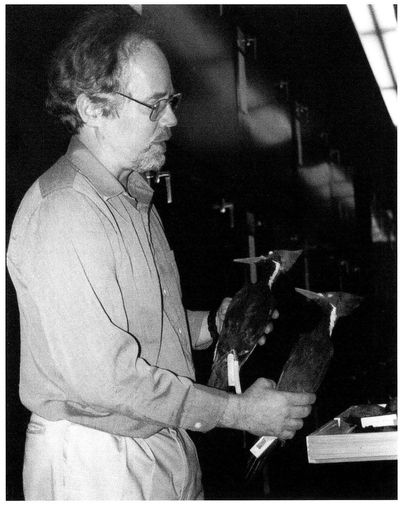
Also by Phillip Hoose
Â
Â
It's Our World, Too!
Young People Who Are Making a Difference
How They Do ItâHow You Can, Too!
Young People Who Are Making a Difference
How They Do ItâHow You Can, Too!
Â
Â
We Were There, Too!
Young People in U.S. History
Young People in U.S. History
Â
Â
Hey, Little Ant
(with Hannah Hoose)
(with Hannah Hoose)
1 Pre-1800
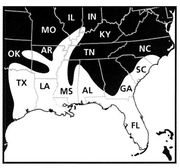
2 1885
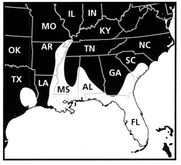
3 1900-1915
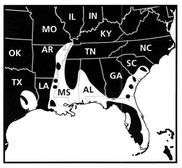
T
HE DRAMATIC LOSS OF IVORY-BILL HABITATâFROM A LARGE EXPANSE OF THE SOUTH-EASTERN United States to a small scrap of land in one swamp forestâcan be tracked in this progression of maps, the first six of which are adapted from James Tanner's research in the 1930s.
HE DRAMATIC LOSS OF IVORY-BILL HABITATâFROM A LARGE EXPANSE OF THE SOUTH-EASTERN United States to a small scrap of land in one swamp forestâcan be tracked in this progression of maps, the first six of which are adapted from James Tanner's research in the 1930s.
In Map I the white area shows the wide expanse of the Ivory-bill's original distribution, which means that the bird might have been found within this area wherever habitat was suitable.
Maps 2 to 4 show the steady loss of habitat as the great river bottom forests of the American South were cleared away after Reconstruction.
Maps 5 and 6 narrow the focus to the Singer Tract, the Louisiana forest where the Ivory-bill made its last known stand in the United States.
Map 7 shows the site of the successful searches for the Ivory-bill in Cuba in the mid-1980s.
A wildlife biologist bands Peregrine Falcon chicks whose nest is in the upper reaches of New Jersey's Walt Whitman Bridge, spanning the Delaware River between New Jersey and Pennsylvania

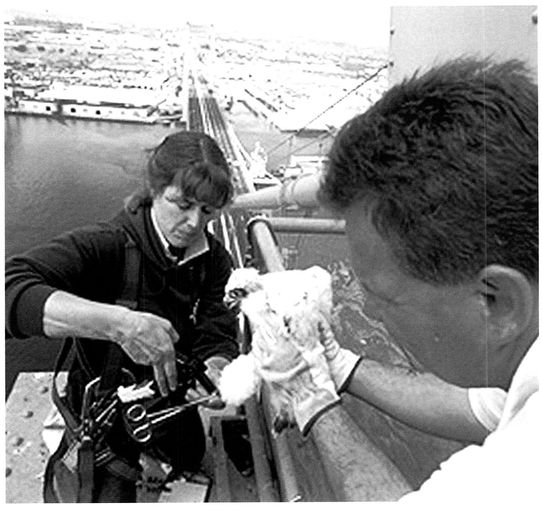
HOPE, HARD WORK, AND A CROW NAMED BETTY
There's one good thing about our species: We like a challenge.
âEdward O. Wilson, Harvard biologist
Planet Earthâthe Twenty-first Century and Beyond
A
LONG WITH TALES OF EXTINCTION, THE TWENTIETH CENTURY ALSO BROUGHT STORIES of hope and recovery. With each passing decade more people seemed to care about birds. In 1962 Rachel Carson, a biologist from Maine, published
Silent Spring,
warning that pesticides sprayed on plants to kill insects were also poisoning birds and other creaturesâincluding us. Though the chemical and food processing industries ridiculed Carson as a “hysterical woman,” she woke up the country. The most harmful pesticides were soon banned. Birds began to recover.
LONG WITH TALES OF EXTINCTION, THE TWENTIETH CENTURY ALSO BROUGHT STORIES of hope and recovery. With each passing decade more people seemed to care about birds. In 1962 Rachel Carson, a biologist from Maine, published
Silent Spring,
warning that pesticides sprayed on plants to kill insects were also poisoning birds and other creaturesâincluding us. Though the chemical and food processing industries ridiculed Carson as a “hysterical woman,” she woke up the country. The most harmful pesticides were soon banned. Birds began to recover.
By the 1980s, bird-watching had become a phenomenally popular activity. Millions of birders took to the field with powerful lightweight binoculars hanging from their necks and color field guides jammed into their pockets. Determined to care for the earth and its creatures, more and more high school students chose careers in biology and conservation. With more biologists, better laws, new conservation groups, and more public support, we began to hear stories of species rescued from the brink of extinction.
One such rescue involved a delicate, sand-colored shorebird that has the evolutionary misfortune of laying its speckled eggs in some of the most popular places on
earthâbeaches. In 1986, the year the Piping Plover
(Charadrius melodus)
was listed under the Endangered Species Act as endangered in part of its range (around the Great Lakes) and threatened in the rest (Atlantic coastal beaches and midwestern rivers and prairie lakes), there were only 2,200 breeding pairs left in the world. Season after season, these little birds struggled to protect their clutches of eggs from beachcombers, dune buggies, dogs, raccoons, gulls, and many other sets of legs and wheels. Things got so bad that some states and Canadian provinces were losing half their plover populations every year.
earthâbeaches. In 1986, the year the Piping Plover
(Charadrius melodus)
was listed under the Endangered Species Act as endangered in part of its range (around the Great Lakes) and threatened in the rest (Atlantic coastal beaches and midwestern rivers and prairie lakes), there were only 2,200 breeding pairs left in the world. Season after season, these little birds struggled to protect their clutches of eggs from beachcombers, dune buggies, dogs, raccoons, gulls, and many other sets of legs and wheels. Things got so bad that some states and Canadian provinces were losing half their plover populations every year.
THE ENDANGERED SPECIES ACT OF 1973
By passing and signing the Endangered Species Act of 1973 (known as the ESA), Congress and President Richard Nixon proclaimed that endangered species of plants and animals were valuable for many reasons. They signaled the determination of the United States to save not only the species themselves, but the ecosystems within which they lived. Two lists were made, one for endangered species (in danger of becoming extinct throughout all or part of their range) and one for threatened species (those likely to become endangered without help). Programs were set up to help the listed species.
Not everyone welcomed this law. Some landowners feared that it would take away their right to use their land as they wished. Some didn't see what the fuss was aboutâwhat good were frogs and birds and plants?
The ESA's first big test came in 1977. Four years before, zoologist David Etnier had discovered a rare little fish known as the Snail Darter
(Percina tanasi)
in the Little Tennessee River. Etnier and his colleagues petitioned to get the darter listed as an endangered species, then filed a lawsuit under the ESA to stop a dam that would have turned the river into a lake and destroyed the darter's habitat. The first judge ruled against them, pointing out that $80 million had already been spent on the dam. But the U.S. Supreme Court overruled him, saying, in Chief Justice Warren Burger's words, “It is clear that Congress intended to halt and reverse the trend toward species extinction whatever the cost.”
(Percina tanasi)
in the Little Tennessee River. Etnier and his colleagues petitioned to get the darter listed as an endangered species, then filed a lawsuit under the ESA to stop a dam that would have turned the river into a lake and destroyed the darter's habitat. The first judge ruled against them, pointing out that $80 million had already been spent on the dam. But the U.S. Supreme Court overruled him, saying, in Chief Justice Warren Burger's words, “It is clear that Congress intended to halt and reverse the trend toward species extinction whatever the cost.”
This meant that government biologists had to create a plan to protect the birds' breeding population. They had no choice but to close some beaches and fence off sections of others during the breeding and nesting season. Howls of protest rose from Cape Cod to Lake Michigan, but the government held firm. Biologists learned year by year what the plovers needed and how to help them.
Today the Piping Plover is recovering, especially in New England. The worldwide population increased by 7.7 percent between 1991 and 1996. While this increase has meant that not everyone can have all parts of a favorite beach at all times during the summer, most people seem willing to share. In some places, “Friends of the Plover” groups have sprung up to protect the plover's breeding habitats. There's still a long way to go, but signs are encouraging.
An even more dramatic success story involves a deadly sky hunter with tapering wings and a distinctive black teardrop below each eye. No hawk is fasterâor more acrobaticâthan the Peregrine Falcon
(Falco peregrinus).
The Peregrine takes its meals by lifting itself above other birds and then folding in its wings and “stooping” down on them, diving at speeds of up to 200 miles per hour. Often it concludes the chase by neatly shearing
off the victim's head in midair with a single stroke of its talons.
(Falco peregrinus).
The Peregrine takes its meals by lifting itself above other birds and then folding in its wings and “stooping” down on them, diving at speeds of up to 200 miles per hour. Often it concludes the chase by neatly shearing
off the victim's head in midair with a single stroke of its talons.
In 1970 there were fewer than one hundred Peregrines left in the lower forty-eight statesâabout 5 percent of their former numbers. They were dying out fast. The main culprit was DDTâa pesticide Rachel Carson targeted in
Silent Spring.
Sprayed on crops to control pests, the poisons in DDT lingered in the tissues of whatever creature ate the crops, such as grasshoppers; then poisoned whatever ate the grasshoppers; and persisted until the poisons reached the top of the food chain. By the time they got to the Peregrine, these poisons made its eggshells so thin that parents crushed their own offspring during incubation. The year after DDT was banned in 1972, the Endangered Species Act was passed and biologists devised a recovery plan for the Peregrines.
Silent Spring.
Sprayed on crops to control pests, the poisons in DDT lingered in the tissues of whatever creature ate the crops, such as grasshoppers; then poisoned whatever ate the grasshoppers; and persisted until the poisons reached the top of the food chain. By the time they got to the Peregrine, these poisons made its eggshells so thin that parents crushed their own offspring during incubation. The year after DDT was banned in 1972, the Endangered Species Act was passed and biologists devised a recovery plan for the Peregrines.
As part of this plan, Dr. Tom Cade, a professor of ornithology at Cornell University, requested that falconersâpeople who legally hunt birds using falcons instead of rifles or arrowsâsend their Peregrine Falcons to him at the “Peregrine Fund.” The idea was to gather the birds together so that they could reproduce in a controlled, protected zoo-like atmosphere before the species died in the wild. The response was immediate: in 1973 twenty new birds were hatched, and the captive population grew steadily year by year.
But where could the new birds be released? Peregrines build their nests high on cliff ledges, where they are commonly raided by the Great Horned Owl, a much bigger bird. There had to be a safer place. Biologists asked themselves: Where are there high ledges with plenty of wild birds flying around for Peregrines to kill and no owls to worry about? Often the answer was right above them: skyscrapers!
NATURAL HERITAGE INVENTORIES
When poachers shot two Ivory-billed Woodpeckers in Florida in 1924, biologists like Arthur Allen worried that the Ivory-bill had become extinct. They had no way of knowing that the species was still in Louisiana, Cuba, and perhaps elsewhere.
It's easier to know now. In 1974 the state of South Carolina and the Nature Conservancy set up the first State Natural Heritage Inventory. They wanted to keep track of all the state's plant and animal species and types of natural communitiesâsuch as forests, marshlands, and prairies.
Workers first researched all the old writings about and museum records of all the state's speciesâjust as Jim Tanner first turned to museum records when he began his Audubon Ivory-bill Fellowship. Then they mapped and recorded data from each old record and put all the information into one central set of files. After that, biologists went out into the field to try to find out if the species was still there. They also ranked how threatened each species was, and how big and healthy each population was. They entered the scientific data into computers.
After a few years the records knitted themselves into a clear picture of the health of South Carolina's biological heritage. Now important habitats for rare species can't be destroyed accidentally.
The idea caught on rapidly. Now there are Heritage Inventories in every state, all the provinces of Canada, and many nations of Central and South America. For more information, log on to
www.natureserve.org
.
www.natureserve.org
.
Each year, more and more Peregrines perch on the ledges of lofty office buildings, scanning city skylines with their sharp eyes for pigeons and gulls. They raise their
young in nest boxes built by biologists. Now falcons and pigeons engage in spectacular life-and-death aerial chases in city skies high above the heads of gaping shoppers. Hotel guests in upper-floor rooms have been known to fling back their curtains only to see a banquet of severed bird heads arrayed on their window ledges.
young in nest boxes built by biologists. Now falcons and pigeons engage in spectacular life-and-death aerial chases in city skies high above the heads of gaping shoppers. Hotel guests in upper-floor rooms have been known to fling back their curtains only to see a banquet of severed bird heads arrayed on their window ledges.
WHAT GOOD IS IT? WHY SAVE BIODIVERSITY?
Conservationists are often asked: What good is it? Why should we care enough about a bird or a butterfly or a turtle or a snake to go out of our wayâor lose money or jobsâto save it? What good is it?
Some answers have to do with the help that creatures give us. Many medicines have come from plants and animals. The blood of armadillos is used in leprosy research. Blood from horseshoe crabs is used to diagnose spinal meningitis in children. Bee venom is used to treat arthritis. It's the same with foods. If we are dependent on only one strain of any crop, it could be wiped out by disease, so we must preserve genetic diversity.
We can't always predict the ways that plants and animals could serve us. During the 1977 Snail Darter controversy, New York senator James Buckley wrote, “What good is a Snail Darter? ⦠We simply don't know. What value would they have placed on the cowpox virus before Jenner? Or on a penicillium mold before Fleming? Yet the life of almost every American is different because of those species.”
Some species help us measure how healthy the environment is. For instance, honey can be used to detect heavy metal pollution. Parts of certain spiderwort plants turn from blue to pink when exposed to some forms of radiation.
But there are reasons to care about biodiversity besides what living things can do for us. Some spiritual traditions hold that because we can reason, humans are responsible for taking care of life forms that we didn't create but have the power to destroy. By this reasoning, any time we knowingly cause the extinction of a species, we also sacrifice a part of our humanity.
On August 20, 1999, after twenty-eight years of never giving up, biologists proudly announced that the Peregrine Falcon had been removed from the U.S. Endangered Species list. Now there were more than 1,700 nesting pairs in the United States, and they were reproducing well both in cities and in their old wild habitatsâa triumph of caring and learning to think like a bird!
AND A CROW NAMED BETTY
Most of the birds that we've tried hardest to rescue have been stars and divas. They have been fast, fierce, or beautiful in our eyes, birds that possess qualities we admire. We love the patriotic brow of a Bald Eagle, the aerial acrobatics of a Peregrine Falcon, and, though it's probably too late to rescue them, the dramatic, arrow-like flight of the Ivory-bill. But in addition to these species there are many more that are small, drab, and quiet. Some haven't even been named yet. Many are sinking fast, usually because their habitats are being destroyed too rapidly for them to adapt, to change their genetic habits, just as the Ivory-billed Woodpecker couldn't diversify its diet in time when its forest home was cleared and grubs became scarce. To save breeding populationsâenough birds to keep reproducingâfor the feathered section of the ark, we're going to have to learn a lot very quickly. Maybe we'll even have to evolve a bit ourselves.
If we can give birds a few thousand more years, they might even learn to help themselves. Consider “Betty.” Betty is a crow
(Corvus moneduloides,
to be exact), a member of a species that lives on the island of New Caledonia in the Pacific Ocean. Crows have long been known to be among the smartest of birds. In 2002 researchers studying crow intelligence set up an experiment to see if they would use tools. They placed a small bucket of food inside a tube so slender that Betty and another crow named Abel couldn't climb into it or reach the food with their bills. Researchers gave the crows two pieces of wire to get the foodâone crooked and one straight.
(Corvus moneduloides,
to be exact), a member of a species that lives on the island of New Caledonia in the Pacific Ocean. Crows have long been known to be among the smartest of birds. In 2002 researchers studying crow intelligence set up an experiment to see if they would use tools. They placed a small bucket of food inside a tube so slender that Betty and another crow named Abel couldn't climb into it or reach the food with their bills. Researchers gave the crows two pieces of wire to get the foodâone crooked and one straight.
Neither crow had any trouble figuring out that you could get the food out of the tube only by using the bent wire to pick up the bucket by its handle. The trouble was, Abel kept stealing the bent wire. Finally, Betty had had enough. She bent the straight wire herself and picked up the bucket. Researchers were amazedâa bird had
made
a tool! “People expect apes to be the pinnacle of intelligence in the animal kingdom because they are our closest relatives,” said Alex Kacelnik of Oxford University, who worked on the experiment. “Now a bird is shown to have greater sophistication than many closer relatives of us humans.”
made
a tool! “People expect apes to be the pinnacle of intelligence in the animal kingdom because they are our closest relatives,” said Alex Kacelnik of Oxford University, who worked on the experiment. “Now a bird is shown to have greater sophistication than many closer relatives of us humans.”
Who knows what we humans and birds can learn about each other and about the world we shareâif, as we began to do for the Lord God bird, we will just give them time.
Other books
Southern Seas by Manuel Vázquez Montalbán
Christmas With the Alexanders by M. Malone
Stranded: A Christmas Story by Fiona Wilde
Beyond Lion Rock: The Story of Cathay Pacific Airways by Young, Gavin
Promises to Keep by Haynes, Elizabeth
The Elusive "O" by Renee Rose
Of Shadow Born by Dianne Sylvan
A Night of Gaiety by Barbara Cartland
Submission by Ardent, Ella
Maplecroft by Cherie Priest
